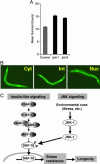JNK regulates lifespan in Caenorhabditis elegans by modulating nuclear translocation of forkhead transcription factor/DAF-16
- PMID: 15767565
- PMCID: PMC555525
- DOI: 10.1073/pnas.0500749102
JNK regulates lifespan in Caenorhabditis elegans by modulating nuclear translocation of forkhead transcription factor/DAF-16
Abstract
DAF-16/forkhead transcription factor, the downstream target of the insulin-like signaling in Caenorhabditis elegans, is indispensable for both lifespan regulation and stress resistance. Here, we demonstrate that c-Jun N-terminal kinase (JNK) is a positive regulator of DAF-16 in both processes. Our genetic analysis suggests that the JNK pathway acts in parallel with the insulin-like signaling pathway to regulate lifespan and both pathways converge onto DAF-16. We also show that JNK-1 directly interacts with and phosphorylates DAF-16. Moreover, in response to heat stress, JNK-1 promotes the translocation of DAF-16 into the nucleus. Our findings define an interaction between two well conserved proteins, JNK-1 and DAF-16, and provide a mechanism by which JNK regulates longevity and stress resistance.
Figures




Comment in
-
All roads lead to FoxO.Cell Metab. 2005 Apr;1(4):215-6. doi: 10.1016/j.cmet.2005.03.008. Cell Metab. 2005. PMID: 16054064
References
-
- Barbieri, M., Bonafe, M., Franceschi, C. & Paolisso, G. (2003) Am. J. Physiol. 285, E1064–E1071. - PubMed
-
- Kimura, K. D., Tissenbaum, H. A., Liu, Y. & Ruvkun, G. (1997) Science 277, 942–946. - PubMed
-
- Ogg, S., Paradis, S., Gottlieb, S., Patterson, G. I., Lee, L., Tissenbaum, H. A. & Ruvkun, G. (1997) Nature 389, 994–999. - PubMed
-
- Lin, K., Dorman, J. B., Rodan, A. & Kenyon, C. (1997) Science 278, 1319–1322. - PubMed
-
- Murphy, C. T., McCarroll, S. A., Bargmann, C. I., Fraser, A., Kamath, R. S., Ahringer, J., Li, H. & Kenyon, C. (2003) Nature 424, 277–283. - PubMed
Publication types
MeSH terms
Substances
Grants and funding
LinkOut - more resources
Full Text Sources
Other Literature Sources
Molecular Biology Databases
Research Materials
Miscellaneous

